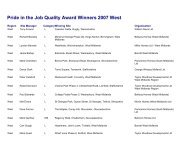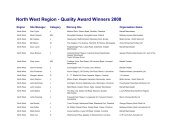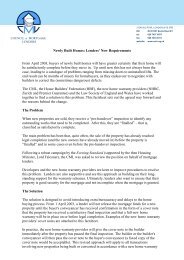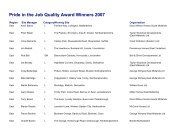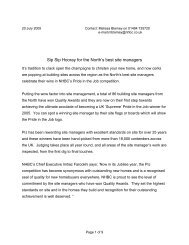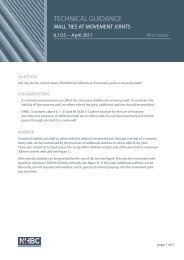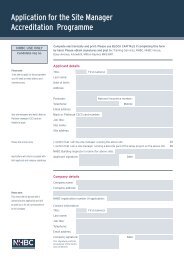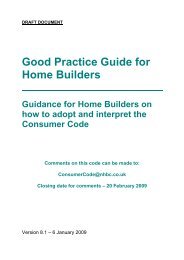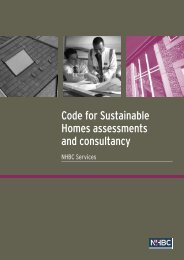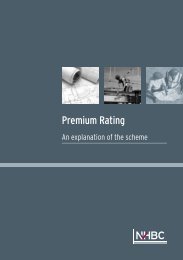Safemark Competency Accreditation Service
Safemark Competency Accreditation Service
Safemark Competency Accreditation Service
- No tags were found...
Create successful ePaper yourself
Turn your PDF publications into a flip-book with our unique Google optimized e-Paper software.
<strong>Safemark</strong> <strong>Competency</strong><strong>Accreditation</strong> <strong>Service</strong>Guidance notes for completingregistration packpage c1
ContentsPageGlossary of terms and abbreviations......................................................... 2Guidance in the use and completion of the registration pack.................................. 3–4Core criteria 1: Health and safety policy organisation .......................................... 5Core criteria 2: Health and safety policy arrangements ........................................ 6Core criteria 3: Competent health and safety advice........................................... 7Core criteria 4: Health and safety training and information..................................... 8Core criteria 5: Individual qualifications and experience. .................................... 9-10Core criteria 6: Health and safety monitoring, audit and review................................. 11Core criteria 7: Workforce involvement. ..................................................... 12Core criteria 8: Accident reporting and enforcement action .................................... 13Core criteria 9: Sub-contractor/consulting procedures.........................................14Core criteria 10: Hazard elimination and risk control........................................... 15Core criteria 11: Risk assessment leading to safe system of work. ...............................16Core criteria 12: Co-operating with others and co-ordinating your work with other contractors. .... 17Core criteria 13: Welfare provision...........................................................18Core criteria 14: CDM co-ordinator’s duties...................................................19page 1
Glossary of terms and abbreviationsTermAPSMeaningThe Association for Project Safety.CDM 2007 The Construction (Design and Management) Regulations 2007.CDM co-ordinatorClientContractorCore criteriaCSCSDesignerICELLPSSiPThe person or organisation that holds the duties of CDM co-ordinator asdefined in the Construction (Design and Management) Regulations 2007.The person or organisation that holds the duties of client as defined in theConstruction (Design and Management) Regulations 2007.For the purpose of the <strong>Safemark</strong> <strong>Competency</strong> Assessment Scheme, acontractor is a person or organisation holding a duty, other than that ofclient, under the Construction (Design and Management) Regulations 2007.The criteria for determining Stage 1 competence as laid out in the HSEdocument, Managing health and safety in construction – Approved Code ofPractice (HSE Books: Code L144: ISBN 9780717662234)Construction Skills Certificate Scheme and allied schemes.The person or organisation that holds the duties of designer as defined inthe Construction (Design and Management) Regulations 2007.Institute of Civil Engineers.Limited liability partnership.The SSiP Forum acts as an umbrella organisation for clients, contractors andconsultants to facilitate structured mutual recognition between schemesand others who carry out health and safety pre-qualification. The SSiP Forummembers are also committed to advise and influence clients, contractors andconsultants about reasonable interpretation and appropriateness of healthand safety competence standards in UK schemes. The Forum embraces thecore guidance on competence and training in the Approved Code of Practice(ACoP) of the Construction (Design and Management) Regulations 2007.page 2
Guidance in the use and completionof the registration packFor your convenience, the document is colour coded to ensure that you can easily access the guidance you need andonly answer those questions relevant to your operations. The colour coding works as follows:Relevant to:Contractor and principal contractor:Relevant guidance and questions have a BLUE stripe on the right-hand side and contains the letters C/PC.CDM co-ordinator:Relevant guidance and questions have a PURPLE stripe on the right-hand side and contains the letters CDM.Designers:(including those businesses involved in architecture, civil engineering, structural engineering, building servicesengineering or building surveys)Relevant guidance and questions have an ORANGE stripe on the right-hand side and contains the letters DES.Where provision of evidence is required, the document includes a tick box to assist you in ensuring that you haveresponded to all relevant questions. Where other supporting information is required on the document,this has been kept to a minimum, with space provided for written comments if required.If you require more space than is available in the supporting information sections, please use a separate sheet ofpaper with your company name and the core criteria number clearly marked on the top of each page.Before you send your submission, you should carefully ensure that all written evidence requested is enclosed, alongwith payment of any fees. Please only provide the evidence requested to support the questions relevant to yourbusiness area. If further evidence is needed by the assessor, we will write to you and explain what we require.C/PCCDMDESPlease note: You should only enclose copies of your documentation and certifications, as we are unable to returnoriginals.Once you have completed the application form, please return to <strong>Safemark</strong> Scheme, Santia House, Parc Nantgarw,Cardiff CF15 7QX, email nhbc.accreditation@santia.co.uk, or call 0292 085 5600.page 3
Guidance in the use and completionof the registration packHow to obtain further advice and guidanceYou should take advice on the technical requirements for the completion of this document from your competenthealth and safety advisor. Details of the core criteria which are mentioned throughout this document can be foundin Appendix 4 (pages 109-113) of the HSE publication, Managing health and safety in construction – Approved Code ofPractice (HSE Books: Code L144: ISBN 9780717662234).Should you not have such advice available, you may be able to obtain it from any trade or professional body of whichyou are a member.Santia <strong>Accreditation</strong> can provide you with advice through our telephone helpline on 0292 085 5600 or by email atnhbc.accreditation@santia.co.uk.Further general health and safety guidance and advice is available at www.hse.gov.uk.ReferencesAccess to the following documents may assist in the completion of this document. Some of these are available onthe HSE website and may be downloaded free of charge. Many HSE leaflets are available free of charge for individualcopies; details are available either at www.hse.gov.uk or www.hsebooks.co.uk.LegislationThe Health and safety at Work etc. Act 1974.Management of Health and safety at Work Regulations 1999.Construction (Design and Management) Regulations 2007.HSE publicationsSuccessful health and safety management (HSE Books: Code: HSG65: ISBN0717612767)Management of health and safety at work – Approved code of practice and guidance (HSE Books: Code: L21: ISBN 9780717624881)Managing health and safety in construction – Approved code of practice (HSE Books: Code L144: ISBN 9780717662234)A guide to the Reporting of Injuries, Diseases and Dangerous Occurrences Regulations 1995 – Guidance on Regulations(HSE Books: Code L73: ISBN 9780717662906)A Guide to the Health and Safety Consultation with Employees Regulations 1996 – Guidance on Regulations(HSE Books: Code L95: ISBN 9780717663118)LegislationAn introduction to health and safety – health and safety in small businesses (HSE Books: Code INDG259: ISBN 9780717626854)Working Together – Guidance on Health and Safety for Contractors and Suppliers (HSE Books: Code INDG268: Web Document Only)Five steps to risk assessment (HSE Books: Code INDG163: ISBN 9780717661893)Managing health and safety – Five steps to success (HSE Books: Code INDG275: ISBN 9780717621705)page 4
Core criteria 1: Health and safety policy organisationfor health and safety – guidance and referencesDetail of core criteria requirementRelevant to:An organisation is expected to have an appropriate policy, regularly reviewed and signed off by the managing directoror equivalent.GuidanceA signed, current copy of the company policy should be available to all employees. The policy should be relevant,providing a clear indication of management responsibilities, health and safety duties and key appointments for healthand safety. It should give an overview of how health and safety is organised, implemented and communicated withinthe organisation. The document should show evidence of regular review and indicate by whose authority it is published.The organisation chart should show the overall management structure, key health and safety duty holders and clearlines of responsibility. Specific appointees should include:• source of competent advice• any director (or similar) with specific responsibility• provision for first aid.The document should demonstrate that the applicant is able to identify and understand the health and safety issuesinvolved in his undertaking, relates them to his business and has systems in place to deal with the issues.What is requiredA policy document relevant to the size and complexity of the organisation must be provided with the application.Note for companies with less than five employees: The exemption from a written health and safety policycontained in the Employers health and safety policy Statements (Exception) Regulations 1975 is acknowledged. Forthe purpose of demonstrating competence under CDM, a brief written statement of the key points of your health andsafety policy is required to show that you understand your duties and have systems in place to comply with them.For an SME with a small number of employees undertaking a limited scope of activities, this may be a single sheet witha bullet-pointed outline statement of how health and safety activities are organised.For a large or multi-divisional company, the document should include details of the organisation and how health andsafety is managed within the organisational structure. This should take into account any multi-divisional structure andhow lines of communication are arranged.The document should be signed by the managing director or equivalent and should preferably have been reviewed inthe past 12 months.C/PCCDMDESWhat is not requiredYou should not produce a large and complex document that does not fit with the size and scope of the company.You should not produce a document that is so generic that it could be used for any activity or company.You should not produce a document that replaces detail with an excessive number of references to legislation,Approved Codes of Practice (ACOPs) or guidance documents.You should not present a document that, where references are included, refers to out-of-date or superseded documents.page 5
Core criteria 2: Health and safety policy arrangements– guidance and referencesDetail of core criteria requirementRelevant to:The health and safety arrangements should clearly set out the arrangements put in place for health and safetymanagement within the organisation. These should be relevant to the nature and scale of the work undertaken by theorganisation. They should set out how the company will discharge its duties under CDM 2007 and should contain aclear indication of how the arrangements are communicated to the workforce.GuidanceA clear explanation of the arrangements which the company has made for putting its policy into effect and fordischarging its duties under CDM 2007.The health and safety arrangements should clearly set out the arrangements for achieving safe systems of work withinthe organisation. This should cover the general operation of the organisation (e.g. compliance with the Display ScreenEquipment Regulations, emergency arrangements, lone working), and also in relation to construction work (design orconstruction).The essence of the arrangements is that they should reflect an active safety regime and pragmatic safe systems ofwork. If generic arrangements are used, there should be clear evidence that they are reviewed against the specificcircumstances of the work situation.Applicants should be able to produce details of the structure of their arrangements and a selection of representativeexamples. The structure might be represented by an index or schedule, if they have a formalised procedure document.The examples should reflect actual situations rather than generic statements, be sufficient to demonstrate realapplication and accurately reflect the standard of other arrangements not presented in this assessment. If they are asmall organisation, the arrangements will be of a commensurate scale. However, they are still expected to have safesystems of work for all hazardous activities.C/PCCDMDESWhat is requiredAn arrangements document relevant to the company must be supplied with the application.The arrangements document may be included as an integral part of the policy document.It should be clear from the arrangements document who is responsible for the management of health and safetywithin the organisation and who has duties. The document should clearly outline the duties for individuals who may benamed or indicated by position.What is not requiredYou should not produce a large and complex document that does not fit with the size and scope of the company.You should not produce a document that is so generic that it could be used for any activity or company.You should not produce a document that replaces detail with an excessive number of references to legislation, AcceptedCodes of Practice (ACOP) or guidance documents.You should not present a document that, where references are included, refers to out-of-date or superseded documents.page 6
Core criteria 3: Competent health and safety advice– guidance and referencesDetail of core criteria requirementRelevant to:The organisation, and its employees, must have ready access to competent health and safety advice, preferably fromwithin your own organisation. The person(s) providing the advice must be able to provide general health and safetyadvice, and also (from the same source or elsewhere) advice relating to construction health and safety issues.GuidanceName and competency details of the source of advice, for example a safety group, trade federation or consultant whoprovides health and safety information and advice.An example from the last 12 months of the advice given and action taken.The source of competent advice should be suitable to meet the needs of the size and type of organisation. It may be anindividual or a company, remembering that the preference is for someone from within the applicant’s organisation.Details submitted should include a CV for the competent advisor, covering qualifications, experience anddemonstration of continuing professional development (CPD) of the individuals concerned.Details of advice given should cover the general operational side of the business, e.g. office work, and also specificareas of design or construction, as appropriate.Evidence submitted will need to be updated on a regular basis and should demonstrate a proactive, pragmaticapproach.C/PCCDMDESWhat is requiredThe applicant should provide name and competency details of the source of health and safety advice of the mainprovider. This may be an employee or, if the advice is from an external source, a safety group, trade federation or aconsultant.An example from the last 12 months of the advice given and action taken.What is not requiredYou are not required to employ a fully qualified health and safety professional if the size and activity of your businessdoes not need it.You should not make claims that an external body or consultant is appointed as your health and safety advisor whenthey are clearly not available to support you on a regular basis.page 7
Core criteria 4: Health and safety training and information– guidance and referencesDetail of core criteria requirementRelevant to:The organisation should have in place, and implement, training arrangements to ensure employees have the skills andunderstanding necessary to discharge their duties as contractors, designers or CDM co-ordinators. A programme forrefresher training should be in place, for example a continuing professional development (CPD) programme or life-longlearning which will keep employees updated on new developments and changes to legislation or good health and safetypractice. This applies throughout the organisation, from board or equivalent to trainees.GuidanceThe requirement here is to provide evidence of a health and safety training culture. The ability to demonstrate aculture of learning is critical. This can be achieved in many ways and relies on senior management and employeesrecognising their responsibilities.Senior management commitment to the learning culture is essential and needs to be demonstrated; this can be by therange and comprehensiveness of learning events. Submission of an action plan which shows continuing training intentmay indicate a forward commitment.The organisation should be able to provide evidence to demonstrate adequate involvement of senior staff, CPD/trainingand information flow in practical terms, e.g.:• involvement of senior staff – procedural examples, attendance at staff meetings, participation in learning activities• training strategy – examples of derivation of personal needs, individual training programmes and evidence that theseare being implemented (for small organisations this can be demonstrated in a simple manner)• demonstration of actual information flows – toolbox talks, lunchtime seminars, bulletin notes, newsletters, feedbackdissemination, change controls, induction programmes (office and site).The evidence submitted need not include individual certificates of training attendance unless these are considerednecessary by the assessor to remove doubt, or unless, for small organisations, this is the only written evidence.C/PCCDMDESWhat is requiredApplicants should provide details of relevant training carried out and programmes of training or CPD relevant to thework they carry out and to the size of the organisation.Examples of evidence of relevant training could include:• training records or registers maintained by management/HR departments• records, certificates of attendance and adequate health and safety induction training for site based workforce• evidence of an active CPD programme and sample toolbox talks• attendance at safety group meetings/Safety and Health Awareness Day (SHAD) events.What is not requiredYou are not required to send copies of every employee’s CSCS or other card, training certificates, etc. If there is aspecific requirement for particular certificates, it will be stated in the covering letter that accompanies theregistration pack.You are not required to produce copies of materials distributed by training providers.page 8
Core criteria 5: Individual qualifications and experience– guidance and referencesDetail of core criteria requirementEmployees are expected to have the appropriate qualifications and experience for the assigned tasks, unless they areunder controlled and competent supervision.Relevant to:C/PCCDMDESGuidanceSubmissions should include details of qualifications and/or experience of specific corporate post holders,e.g. board members and health and safety advisor.Other key roles should be named or identified and details of relevant qualifications and experience provided. Thenumber of people for which details are provided will depend upon the size of the business and the nature of its work.Although the ACOP text includes project-related data, for the purpose of this assessment it is essential to concentrateon the business organisation in this section. This will allow Stage 1 to remain more of a generic statement.For substantial organisations, a reasonable view needs to be taken as to the necessary quantity of data to be provided.C/PCCDMDESContractorsDetails of number/percentage of people employed or otherwise engaged in the project who have passed a constructionhealth and safety assessment, e.g. the ConstructionSkills touch screen test, or equivalent affiliated schemes.For site managers, details of any specific training, such as the ConstructionSkills ‘Site Management Safety TrainingScheme’ certificate or equivalent.For professionals, details of qualifications and/or professional institution membership.For site workers, details of any relevant qualifications or training, such as S/NVQ certificates.Evidence of a company-based training programme suitable for the work to be carried out.C/PCCDM co-ordinatorsDetails of number/percentage of people employed or otherwise engaged in the project who have passed a constructionhealth and safety assessment, e.g. the ConstructionSkills touch screen test, or equivalent affiliated schemes.Evidence of health and safety knowledge, such as NEBOSH Construction Certificate.Details of professional institution membership and any other specific qualifications, such as member of the Register ofCDM Co-ordinators administered by the APS, ICE construction H&S register.Evidence of a clear commitment to training and the CPD of staff.Design organisationsDetails of number/percentage of people employed or otherwise engaged in the project who have passed a constructionhealth and safety assessment, e.g. the ConstructionSkills touch screen test, or equivalent affiliated schemes.Details of any relevant qualifications and/or professional institution membership and any other specific qualifications,such as ICE construction H&S Register, NEBOSH Construction Certificate, APS Design Register.CDMDESpage 9
What is requiredContractors:Details of relevant qualifications and experience of relevant key figures in the organisation must be suppliedThis will include percentage attainment for operatives, supervisors, site managers/agents, contract directors, etc. insufficient detail to give an adequate overall picture of the organisation and its training culture.Details of planned progression with training/qualifications and, where appropriate, CPD should also be given.C/PCRelevant to:CDM co-ordinators:Details of relevant qualifications and experience of relevant key figures in the organisation must be supplied.This will include percentage attainment for construction health and safety assessments, NEBOSH ConstructionCertificates, professional institution memberships, including APS, ICE etc. in sufficient detail to give an adequate overallpicture of the organisation and its training culture.Details of planned progression with training/qualifications and CPD should also be given.CDMDesign organisations:Details of relevant qualifications and experience of relevant key figures in the organisation must be supplied.This will include percentage attainment for professional institution memberships, such as ICE Construction H&S register,NEBOSH qualifications, APS registrations in sufficient detail to give an adequate overall picture of the organisation andits training culture.Details of planned progression with training/qualifications and CPD should also be given.DESWhat is not requiredYou are not required to send copies of all certificates held by your staff. If there is a specific requirement for particularcertificates it will be stated in the covering letter that accompanies the registration pack.You are not required to produce copies of materials distrivbuted by training providers.You are not required to produce portfolios of evidence submitted for S/NVQ assessments.C/PCCDMDESpage 10
Core criteria 6: Health and safety monitoring,audit and review – guidance and referencesDetail of core criteria requirementRelevant to:Organisations should have a system for monitoring procedures, for auditing them at periodic intervals and forreviewing them on an ongoing basis.GuidanceDepending upon the size of organisation, this might vary from a simple record, discussions/reports to senior managersto a formal quality-assured report.The records and/or reports should demonstrate the issues raised, the action taken as a consequence and how this isreviewed and responded to by senior management.This item includes the monitoring of sub-contractors and sub-consultants.What is requiredEvidence to demonstrate a strategy and schedule of monitoring, audit and review of activities with selective reports orsimilar must be supplied.C/PCCDMDESThis could, depending on the size of the organisation and the complexity of the work it carries out, include suchdocuments as:• records of site inspections by management, responsible persons or internal/external health and safety advisors• formal audit reports by internal or external auditors/audit bodies.It is particularly important that the evidence demonstrates the action taken by line management (with examplesof senior management involvement) for instigating and following through on audits, etc. Lines of responsibility forfollowing through on issues raised should be clear.What is not requiredYou should not commission audits or reviews of your systems or your working practices by external bodies.page 11
Core criteria 7:Workforce involvement – guidance and referencesDetail of core criteria requirementRelevant to:Organisations should have, and implement, an established means of consulting with their workforce on health andsafety matters.GuidanceOrganisations should be able to provide evidence showing how consultation is carried out.Records of health and safety meetings/committees.Names of appointed safety representatives (trades union or other).For those employing less than five employees, details of consultations with your employees.This applies to all organisations. (If no written record is available, you will have to demonstrate this in some other way.)What is requiredC/PCCDMDESRecords of health and safety meetings and examples of actual workforce involvement in health and safety mattersmust be provided.Names of representatives should be provided, where applicable, and an indication of whether the organisationoperates under the Safety Representatives and Safety Committees Regulations 1977 or the Health and Safety(Consultation with Employees) Regulations 1996.What is not requiredYou are not required to appoint safety representatives unless you wish to do so or there is a statutory requirement foryou to do so.You are not required to recognise trade union safety representatives unless you wish to do so.page 12
Core criteria 8: Accident reporting and enforcement action– guidance and referencesDetail of core criteria requirementRelevant to:Organisations should have records of RIDDOR reportable events for at least the last three years. They should have inplace a system for reviewing all incidents and recording the actions taken as a result. Organisations should record anyenforcement actions taken against them over the last five years and the actions taken to remedy matters subject toenforcement action.GuidanceOrganisations should be able to provide evidence showing the way in which they record and investigate accidents andincidents.Although an adequate record system is necessary in order to demonstrate good management and timely reporting, thekey to improvement is in the analysis of accidents and near misses, and the actions taken to avoid repetition.What is requiredRecords of the last two accidents/incidents and action taken to prevent recurrence must be supplied, if applicable.C/PCCDMDESRecords of any enforcement action taken over the last five years, and what action was taken to put matters right, mustbe supplied, if applicable.Statistics showing incidence rates of major injuries, over-seven-day injuries, reportable cases of ill health anddangerous occurrences for the last three years must be supplied, if applicable.Records of incidents that occurred whilst the company traded under a different name, and any incidents that occur todirect employees or labour only subcontractors must be supplied, if applicable.What is not requiredYou are not required to keep and provide detailed records of very minor accidents and near misses.You are not required to keep and provide accident records going back beyond three years.You are not required to keep and provide details of enforcement action taken against sub-contractors working for you.page 13
Core criteria 9: Sub-contracting/consulting procedures– guidance and referencesDetail of core criteria requirementRelevant to:Organisations should have in place arrangements for appointing competent sub-contractors/consultants. They shouldbe able to demonstrate how they ensure that sub-contractors will also have arrangements for appointing competentsub-contractors/consultants. Arrangements should be in place for monitoring sub-contractor performance.GuidanceOrganisations should be able to provide evidence showing how they require similar standards of competenceassessment from sub-contractors to the standards expected of them.Assessment of contractors and sub-contractors should match this process or be fully detailed if different.The key here is an insistence on the organisations, sub-contractors/consultants assessing any further sub-contractors/consultants they employ, to at least the same standard as achieved through the Stage 1 (and Stage 2 when applicable)process outlined in the ACOP.Note: For monitoring of sub-contractors/sub-consultants see core criteria 6.What is requiredC/PCCDMDESEvidence of how sub-contractors are assessed for competence must be supplied.This can include examples of sub-contractor assessments carried out or how the organisation monitors sub-contractorperformance.What is not requiredYou are not required to produce long-winded questionnaire responses you have received from your sub-contractorsthat do not deal with the core criteria detailed in this document.You are not required to repeat contractor assessments for every contract on which you use sub-contractors.You are not required to ask the same questions for every sub-contractor, regardless of the type of work they willundertake (i.e. cleaners, office workers versus high-risk construction trades such as scaffolders).page 14
Core criteria 10: Hazard elimination and risk control– guidance and referencesDetail of core criteria requirementRelevant to:Designers should have in place, and implement, arrangements to meet their duties under regulation 11 of CDM 2007.GuidanceThe emphasis here should be on practical measures which reduce particular risks arising from the design, not onlengthy procedural documentation highlighting generic risks. Examples of hazard elimination, etc. should be providedand reflect the guidance given on this topic in industry standards and reference documents.Assessors will wish to see evidence of good, compliant practice in action.Note: On many projects, some detailed designers (e.g. M&E, temporary works) will not be appointed until constructionwork commences. This requires robust procedures for co-operation and co-ordination; how this occurs and is managedshould be illustrated.What is requiredDESEvidence must be submitted that shows how the organisation:• ensures co-operation and co-ordination of design work within the design team and with other designers/contractors• ensures that hazards are eliminated and any remaining risks controlled• ensures that any structure which will be used as a workplace will meet relevant requirements of the Workplace(Health Safety and Welfare) Regulations 1992• manages changes to designs.Evidence should include examples showing how risk was reduced through design.What is not requiredYou are not required to produce large amounts of paperwork that is not focused on the requirements of the core criteria.page 15
Core criteria 11: Risk assessment leading to a safe systemof work – guidance and referencesDetail of core criteria requirementRelevant to:Organisations should have in place procedures for carrying out risk assessments and for developing and implementingsafe systems of work/method statements. The identification of health issues is expected to feature prominently in thissystem.GuidanceOrganisations should be able to show how they identify significant health and safety risks, including ill health, and howthey will be controlled through sample risk assessments/safe systems of work/method statements.If organisations employ less than five persons and do not have written arrangements, they should be able to describehow they achieve the above.Standards of risk assessment and safe methods/systems of work vary significantly. The intent here is to demonstratesuitable and sufficient procedures.What constitutes ‘suitable and sufficient’ will depend upon the nature of the work, but must reflect the importanceof this risk area. Ill health has been singled out in order to reflect the importance of this aspect and its growingprominence in regulations.Where organisations employ sub-contractors, they will have responsibilities towards the sufficiency of theirsystems, etc. This should be reflected in the risk assessment processes.What is requiredOrganisations must provide evidence of procedures (or equivalent approach) to demonstrate how hazards are initiallyidentified and risks mitigated. This should include examples of monitoring of employees and sub-contractors, unlessthis is covered under core criteria 6.Risk assessments must be in writing. This is notwithstanding the provision in the Management of Health and Safetyat Work Regulations 1999 (Regulation 5(2)) that an employer with less than five employees is not required to producewritten assessments of risk.Examples of evidence could be:• a range of safe methods/systems of work illustrating how the principles of prevention have been applied in defining them• a range of safe methods/systems of work relating specifically to health issues, including health surveillance if undertaken.C/PCWhat is not requiredYou should not produce risk assessments detailing the obvious hazards over and over again.You are not required to produce risk assessments that only deal with generic issues, and do not deal with hazardsparticular to the site you are working on.You are not required to document all your risk assessments as part of a management system.You should not document the whole process instead of the most important issues to be controlled(the ‘significant findings’).You are not required to engage in expensive health programmes for all of your workforce as a matter of routine– only for those of your employees who are at risk of exceeding legal limits.You are not required to provide your own doctor/nurse or surveillance/screening for employees who are not at risk.page 16
Core criteria 12: Co-operating with others and co-ordinatingyour work with other contractors – guidance and referencesDetail of core criteria requirementRelevant to:Organisations should be able to illustrate how co-operation and co-ordination of their work is achieved in practice, andhow they involve the workforce in drawing up method statements/safe systems of work.GuidanceCo-operation and co-ordination are key elements to successful health and safety risk management. Organisationsshould be able to provide evidence of how the company co-ordinates its work with other trades and organisations.What is requiredApplicants must provide evidence of how they co-operate with, and co-ordinates their activities with, others involvedin the workplace.C/PCEvidence should include examples of actual co-operation measures, as well as intent.Evidence could also include sample risk assessments, procedural arrangements, project and team meeting notes.Evidence can be provided from projects where applicants have been involved or employed by a principal contractorwho has included applications, amongst others, in the consultation process, where this has been documented.What is not requiredYou are not required to provide a vast amount of paperwork that does not relate to work that you do.You are not required to put in place a system of consultation that does not fit the size of your business or that isoverly time-consuming for the results expected.page 17
Core criteria 13:Welfare provision – guidance and referencesDetail of core criteria requirementRelevant to:Organisations should be able to demonstrate how they will ensure that appropriate welfare facilities will be in placebefore people start work on the site.GuidanceCDM 2007 requires adequate welfare provision to be available at commencement of the construction phase of allprojects.What is requiredApplicants should provide evidence of commitment to provision of appropriate welfare facilities in the health andsafety policy.Supporting evidence could be from contracts with welfare facility providers; details of type of welfare facilitiesprovided on previous projects (separately identifying toilets, rest rooms and washing facilities, as Schedule 2 of CDM2007), a brief description of the project and the date the facility was provided in relation to the site commencementdate. If temporary facilities were provided, indicate also the date at which these were replaced by the permanentfacility.C/PCIf a sub-contractor is relying on shared facilities, a statement of policy to ensure adequate provision by others, beforeemployees commence on site, should be provided.What is not requiredYou are not required to provide mess/toilet facilities where you have already agreed with another contractor touse theirs.page 18
Core criteria 14: CDM co-ordinator’s duties– guidance and referencesDetail of core criteria requirementRelevant to:Organisations should be able to demonstrate how they go about encouraging co-operation, co-ordination andcommunication between designers.GuidanceCDM co-ordinator’s duties should be described in the form of actual examples of corporate procedures and processes,rather than by generic procedures.Note: Individual competence is covered in core criteria 5.What is requiredCDMApplicants should supply sufficient examples of parts of corporate procedures to show that they comply with theduties of CDM co-ordinator.Corporate procedures should be supported by examples (minutes, notes) of interaction with designers and clients andinternal reviews of processes and outcomes.What is not requiredLarge amounts of paperwork that do not focus on the practical aspects of the CDM co-ordinator’s role.page 19F272b 08/12



